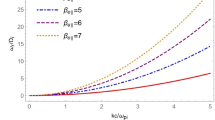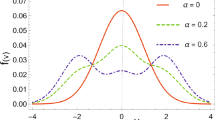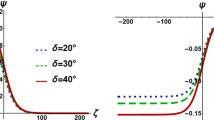Abstract
We suggest a two-step mechanism for the generation of the parallel electric field at the Alfvén wave. At the first step, the coupling with the compressional mode due to the magnetic field non-uniformity and finite plasma pressure provides the parallel magnetic field of Alfvén wave. At the second step, the compressional mode acquires the parallel electric field due to coupling with the electrostatic mode as required by the quasi-neutrality condition in kinetics. The parallel electric field acquired by the Alfvén mode is considerably larger than that due to the single-step coupling between the Alfvén and electrostatic modes in kinetics.
Similar content being viewed by others
Avoid common mistakes on your manuscript.
1 Introduction
The ultra-low-frequency (ULF) waves, that is the waves with frequencies much less than the ion gyrofrequency, are widely observed in space plasmas: in the planetary magnetospheres (Glassmeier et al. 2004), interplanetary magnetic field (Potapov et al. 2013), Sun’s atmosphere (Nakariakov et al. 1999), cometary atmospheres (Le et al. 1989). Some of them can be identified with various compressional modes (Leonovich and Kozlov 2009; Leonovich et al. 2010; Klimushkin and Mager 2011), but vast majority of the ULF waves are interpreted as the shear Alfvén modes (Glassmeier et al. 2004).
An importance of the ULF waves for the space plasma physics is caused, in particular, by their ability to accelerate the plasma particles. Indeed, there are experimental signatures that the ULF waves are responsible for the acceleration of the auroral electrons (Keiling et al. 2002) and radiation belt electrons (Mathie and Mann 2001; Potapov et al. 2012) in the Earth’s magnetosphere, the electrons in the Io’s plasma torus (Das and Ip 1992). The Alfvén waves are often involved for explanation of the heating of the Sun’s corona (e.g. Nakariakov et al. 1999).
Sometimes, plasma energization by the nonlinear ponderomotive forces is supposed (Allan 1993; Guglielmi et al. 1999; Dmitrienko 1997, 2011; Nekrasov and Feygin 2005; Lundin and Guglielmi 2006). The transverse electric field E ⊥ is usually involved for the studies of the acceleration of the radiation belt electrons (Ukhorskiy et al. 2009). But the most popular mechanism involves the parallel electric field E ∥ (Hasegawa 1976; Genot et al. 2000; McClements and Fletcher 2009; Bingham et al. 2013).
However, in usual MHD treatment, the Alfvén wave parallel electric field is assumed to be zero, E ∥=0. Thus, kinetic effects should be taken into account. One such effect is electron inertia that provides coupling of Alfvén wave with the electrostatic mode causing the formation of the inertial Alfvén wave with nonzero E ∥ (Lysak and Lotko 1996). The parallel to transverse electric field ratio E ∥/E ⊥ is very small, therefore, this mechanism is not very effective for ULF modes. To overcome this difficulty, various kinetic instabilities were proposed (Dwivedi et al. 2001; Bespalov et al. 2006; Agarwal et al. 2011; Chen et al. 2013; Arshad and Mirza 2013). However, the problem cannot be considered as being solved yet.
In this paper, another approach is suggested that assumes a two-step generation of the parallel electric field at the Alfvén mode. As was shown in MHD, the Alfvén wave acquires considerable parallel magnetic field (B ∥) due to the coupling with the compressional modes owing to plasma inhomogeneity (e.g. Agapitov et al. 2008; Mazur et al. 2013). The second step assumes that the compressional mode is coupled with the wave parallel electric field, as demanded by the quasi-neutrality condition in kinetics. As a result, the Alfvén mode acquires considerable parallel electric field in the non-uniform plasma.
2 Initial equations
Let us consider a one-dimensionally inhomogeneous cylinder model of the magnetosphere where the magnetic field lines are concentric circles with radius R. All the plasma parameters (plasma pressure P(x), ambient magnetic field B(x) and others) vary across the magnetic shells only. The radius R has the role of the radial coordinate x. The coordinate y along the cylinder axis corresponds to the azimuthal coordinate in the magnetosphere, the coordinate l ∥ is along the magnetic field line.
Let us assume the isotropic Maxwellian equilibrium distribution function
where n is the plasma number density, V is the particle thermal velocity. Then the equilibrium condition is written as
where prime denotes differentiation over the radial coordinate x. The dependence of the wave variables on the spatio-temporal coordinates has the form
where ω is the wave frequency, k x and k y are the wave-vector’s radial and azimuthal component, respectively, with the former being determined from the leading order WKB approximation (Leonovich and Mazur 1993). In what follows, the transversally small scale waves are considered: k ⊥≫k ∥, where k ⊥ is the wave vector transverse component, \(k_{\perp}^{2}=k_{x}^{2} + k_{y}^{2}\).
The wave phenomena with the wave frequency ω much less than the gyrofrequency ω c are conventionally studied within the gyrokinetics (Chen and Hasegawa 1991). In this formalism, the wave’s electromagnetic field can be described via three variables. The first one is b=ωB ∥/c, where B ∥ is the longitudinal magnetic field of the wave. The second one ψ is related to the longitudinal vector potential by A ∥=−(ic/ω)∂ψ/∂l ∥, where ω is the wave frequency. The third variable is the electrostatic potential ϕ. However, instead of the latter, it is convenient to use the “parallel potential” ϕ ∥=ϕ−ψ.
In the gyrokinetic formalism, the gauge in which \(\nabla\cdot\vec{A} =0 \) is selected (Antonsen and Lane 1980), thus the transverse vector potential A ⊥=(k ∥/k ⊥)A ∥ can be neglected in the limit k ⊥≫k ∥. Then \(\vec{B}=\nabla\times\vec{A}_{\|}\) and the transverse magnetic field of the wave is expressed in terms of the variable ψ. The parallel electric field of the wave is expressed through the parallel potential as E ∥=−ik ∥ ϕ ∥. In what follows we assume that the parallel electric field of the wave is much less than the perpendicular component (although E ∥≠0). Then we can find from the Faraday law \(\nabla\times\vec{E} = (i \omega/c) \vec{B}\) that the transverse electric can be expressed in terms of the variable ψ as E ⊥=−ik ⊥ ψ.
The field variables are related to each other through the quasi-neutrality condition, transverse Ampere law, and the parallel Ampere law [see equations (12–14) in Chen and Hasegawa (1991)]. In this paper, the following approach will be adopted. First, we well assume the negligibly small parallel electric field, that is ϕ ∥≪ψ. Then, the wave field is determined by the variables b and ψ related to each other by the reduced equations for the transverse and parallel Ampere law. Then, the quasi-neutrality condition will be considered, which can be treated as the equation for the parallel potential expressed in terms of the variables b and ψ determined on the previous step.
In what follows, the ion Larmor radius ρ i will be assumed to be small, k ⊥ ρ i ≪1.
3 Relation between the transverse and compressional modes
The variables b and ψ are related by the equations
[see equations (21–22) in Chen and Hasegawa (1991)], where L M and L A are the operators for the compressional and transverse (Alfvén) modes, respectively, and L c is the coupling operator. In the general form for the one-dimensionally inhomogeneous cylinder model these operators are written in Klimushkin and Mager (2011). Here we consider the quasi-MHD limit, where ω≫k ∥ V ∥ and the velocity of the gradient-curvature drift is small. The opposite case was considered in Klimushkin and Mager (2012).
Let us introduce the diamagnetic drift frequency
where T=V 2/2 is the plasma temperature (remind that the prime denotes differentiation over the radial coordinate). Then the operators are recast as
All of the operators contain also imaginary terms, but we will consider them negligibly small.
The solution of the system (2, 3) reveal existence of two branches of the ULF modes: the Alfvén-ballooning mode with the characteristic frequency ω∼k ∥ v A , and the drift compressional mode with the frequency ω∼ω ∗. The dispersion properties of these modes and corresponding instability conditions are studied in Klimushkin and Mager (2011), Klimushkin et al. (2012).
Here we bound ourselves with the limit ω≫ω ∗. After expressing b from (2) and substituting it into (3) we get the equation for the Alfvén-ballooning mode
where
is the ballooning term.
Further, Eq. (2) in the limit ω≫ω ∗ can be written as
Remind that P′ is the plasma pressure radial gradient connected with the curvature radius R according to the equilibrium condition (1).
Thus, in a non-uniform finite-pressure plasma the Alfvénic perturbation is always accompanied by the parallel magnetic field. On the order of magnitude,
The same expressions (9, 10) can be obtained also in MHD (Mager and Klimushkin 2002).
4 The parallel electric field in the uniform plasma
In the limits ω≫k ∥ V ∥, ω≫ω ∗, the quasi-neutrality condition can be written in the form
where 〈...〉 denotes the averaging over the velocity space, q and m are the charge and the mass of the particle, J n =J n (k ⊥ v ⊥/ω c ) is the n th order Bessel function, ε=v 2/2 is the particle energy. This equation is an analogy of Eq. (12) from Chen and Hasegawa (1991) but written for the case of the circular field lines.
This equation describes the generation of the parallel electric field ϕ ∥ by the transverse electric field ψ and parallel magnetic field B ∥ already determined from Eqs. (8,9).
Let us assume B ∥=0, which is justified for the Alfvén mode in the uniform plasma. Then we integrate Eq. (11) for the case of the small ion Larmor radius, k ⊥ ρ i ≪1, and the electrons with the thermal velocities much higher than the parallel phase speed of the wave, V ∥≫ω/k ∥. As a result, we have
The lower index H here refers to the uniform plasma case.
First, let us consider the case when the Alfvénic frequencies are higher than v s k ∥, where \(v_{s} = v_{e} \sqrt{m_{e}/m_{i}}\) is the ion-sound speed. Then, taking into account also definitions E ∥=−ik ∥ ϕ ∥, E ⊥=−ik ⊥ ψ, Eq. (12) can be written in the form
Due to the small ion Larmor radius the inequality E ∥H ≪E ⊥ holds.
Now let us consider the opposite case, ω≪v s k ∥. Then only the second term in the left-hand side of Eq. (12) must be kept, and the parallel electric field equals
This time, the inequality E ∥H ≪E ⊥ is a consequence of the small wave frequency compared with the ion gyrofrequency.
Equations (13, 14) confirm that in a uniform plasma the parallel electric field of the Alfvén mode is very small compared with its transverse electric field.
5 The parallel electric field in the non-uniform plasma
Keeping in Eq. (11) both ψ and B ∥ terms, we find after integration:
The parallel magnetic field B ∥ can be expressed through ψ according to Eq. (10). The transverse and parallel electric fields are expressed as E ⊥=−ik ⊥ ψ, E ∥=−ik ∥ ϕ ∥, respectively.
Let us consider two cases: cold electrons (ω≫v s k ∥) and hot electrons (ω≪v s k ∥).
For the frequencies ω≫v s k ∥ we get:
On the order of magnitude, the parallel electric field generated by this mechanism is
In the opposite case, ω≪v s k ∥, we get:
or on the order of magnitude
Although in both cases the parallel electric field is small, E ∥≪E ⊥, but it is
times stronger than the in the homogeneous plasma according to Eqs. (13) and (14). For typical frequencies of the Pc5 ULF waves in the Earth’s magnetosphere and azimuthal wave numbers m∼5 typical for the field line resonances, this factor can be estimated as η∼102–103.
The work of the parallel electric field per unit time is expressed as
while the work of the transverse electric field per unit time is
where u d is the gradient-curvature drift velocity. On the order of magnitude,
Thus, in the case of cold electrons (ω≫v s k ∥) the works of the parallel and the transverse electric field are related as
and in the case of the hot electrons (ω≪v s k ∥)
(for the Alfvénic frequencies ω∼k ∥ v A ). In both cases, this ratio can be rather large value.
The estimates (20, 24, 25) justify the necessity to consider the parallel magnetic field of the Alfvén mode for E ∥ generation.
6 Conclusions
Due to the coupling with the compressional mode in a finite pressure plasma embedded in a non-uniform magnetic field, the Alfvén mode gains the field-aligned component of the wave magnetic field. The parallel magnetic field of the wave is coupled with the parallel electric field according to the kinetic quasi-neutrality condition. As a result, the Alfvén mode parallel electric field is considerably larger than that due to the direct coupling with the electrostatic mode.
References
Agapitov, A.V., Cheremnykh, O.K., Parnowski, A.S.: Adv. Space Res. 41, 1682 (2008)
Agarwal, P., Varma, P., Tiwari, M.S.: Indian J. Pure Appl. Phys. 49, 91 (2011)
Allan, W.: J. Geophys. Res. 98(A7), 11383 (1993)
Antonsen, T.M., Lane, B.: Phys. Pluids 23, 1205 (1980)
Arshad, K., Mirza, A.M.: Astrophys. Space Sci. (2013). doi:10.1007/s10509-013-1664-2
Bespalov, P.A., Misonova, V.G., Cowley, S.W.H.: Ann. Geophys. 24, 2313 (2006)
Bingham, R., Eliasson, B., Mendon, J.T., Stenflo, L.: Phys. Scr. 87, 058201 (2013)
Chen, L., Hasegawa, A.: J. Geophys. Res. 96, 1503 (1991)
Chen, L., Wu, D.J., Huang, J.: J. Geophys. Res. 118, 2951 (2013)
Das, A.C., Ip, W.-H.: Planet. Space Sci. 40, 1499 (1992)
Dmitrienko, I.S.: J. Plasma Phys. 57, 311 (1997)
Dmitrienko, I.S.: Geomagn. Aeron. 51, 1160 (2011)
Dwivedi, A.K., Varma, P., Tiwari, M.S.: Planet. Space Sci. 49, 993 (2001)
Genot, V., Louran, P., Mottez, F.: J. Geophys. Res. 105, 27611 (2000)
Glassmeier, K.-H., Klimushkin, D., Othmer, C., Mager, P.: Adv. Space Sci. 33, 1875 (2004)
Guglielmi, A., Hayashi, K., Lundin, R., Potapov, A.: Earth Planets Space 51, 1297 (1999)
Hasegawa, A.: J. Geophys. Res. 81, 5083 (1976)
Keiling, A., Wygant, J.R., Cattell, C., et al.: J. Geophys. Res. 107(A7) (2002). doi:10.1029/2001JA900140
Klimushkin, D.Y., Mager, P.N.: Planet. Space Sci. 59, 1613 (2011)
Klimushkin, D.Y., Mager, P.N.: Plasma Phys. Control. Fusion 54 (2012). doi:10.1088/0741-3335/54/1/015006
Klimushkin, D.Y., Mager, P.N., Pilipenko, V.A.: Earth Planets Space 64, 777 (2012)
Le, G., Russell, C.T., Gary, S.P., et al.: J. Geophys. Res. 94(A9), 11989 (1989)
Leonovich, A.S., Mazur, V.A.: Planet. Space Sci. 41, 697 (1993)
Leonovich, A.S., Kozlov, D.A.: Plasma Phys. Control. Fusion 51, 18 (2009)
Leonovich, A.S., Kozlov, D.A., Edemskiy, I.K.: Planet. Space Sci. 58, 1425 (2010)
Lundin, R., Guglielmi, A.: Space Sci. Rev. 127, 1 (2006)
Lysak, R., Lotko, W.: J. Geophys. Res. 101(A3), 5085 (1996)
Mager, P.N., Klimushkin, D.Y.: J. Geophys. Res. 107(A11), 1356 (2002)
Mathie, R.A., Mann, I.R.: Geophys. Res. Lett. 106, 29783 (2001)
Mazur, N.G., Fedorov, E.N., Pilipenko, V.A.: Earth Planets Space 65, 463 (2013)
McClements, K.G., Fletcher, L.: Astrophys. J. 693, 1494 (2009)
Nakariakov, V.M., Ofman, L., DeLuca, E.E., Roberts, B., Davila, J.M.: Science 285, 862 (1999)
Nekrasov, A.K., Feygin, F.Z.: Phys. Scr. 71, 310 (2005)
Potapov, A.S., Tsegmed, B., Ryzhakova, L.V.: Cosm. Res. 50(2), 124 (2012)
Potapov, A.S., Polyushkina, T.N., Pulyaev, V.A.: J. Atmos. Sol.-Terr. Phys. 102, 235 (2013)
Ukhorskiy, A.Y., Sitnov, M.I., Takahashi, K., Anderson, B.J.: Ann. Geophys. 27, 2173 (2009)
Acknowledgements
The work was supported by Russian Foundation for Basic Research grants 12-05-00121-a and 12-05-98522-r-vostok-a, Program #22 of the Presidium of the Russian Academy of Sciences.
Author information
Authors and Affiliations
Corresponding author
Rights and permissions
About this article
Cite this article
Klimushkin, D.Y., Mager, P.N. The Alfvén wave parallel electric field in non-uniform space plasmas. Astrophys Space Sci 350, 579–583 (2014). https://doi.org/10.1007/s10509-013-1774-x
Received:
Accepted:
Published:
Issue Date:
DOI: https://doi.org/10.1007/s10509-013-1774-x




